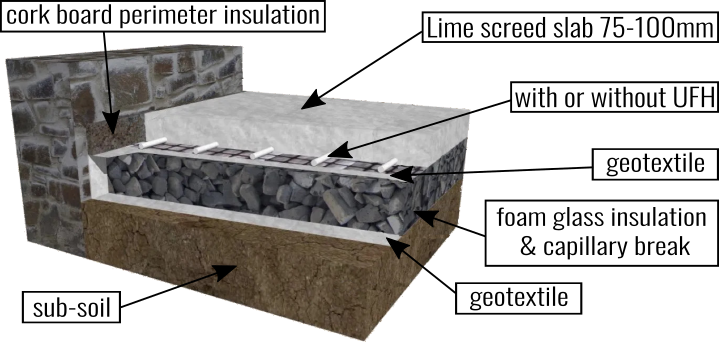greener materials
making homes healthy

Natural Hydrolic Lime
Limecrete, a combination of natural hydraulic lime (NHL) and aggregate, is seen as a ‘green’ building product as its manufacturing carbon footprint is lower than producing concrete.
It also absorbs Carbon Dioxide in the drying process.
A Limecrete slab enables vapour to escape, reducing damp and mould issues, and therefore is often prescribed for listed buildings for restoration authenticity and practical reasons such as vapour control.
With high flexural strength, Limecrete copes with absorbing natural movement in both old and new buildings and this flexibility, coupled with high thermal mass, makes Limecrete ideal for use with the reconstruction of solid floors as well as with under floor heating (UHF).


Foam Glass Aggregate
As a sub-slab insulator, foam glass can be used to thermally insulate beneath a Limecrete slab while also acting as a drainage layer/capillary break.
As most period properties have their floors built directly on earth, usually with a thin layer of lime mortar and ash underneath, it is common for moister to rise to the surface, by capillary action, making your floor wet, particularly during rainy periods.
As Foam Glass can be used to create a breathable sub-base, it is an ideal material for period floor construction.
Foam glass can replace rigid foam board and crushed stone aggregate as a 2 in 1 solution for insulation and moisture separation i.e. a capillary break.
Physical Characteristics
Load bearing – 116 psi compressive strength at 10% deformation, post compaction
High friction angle – Pieces allow for mounds up to 45° slopes
Frost heave resistant – Will prevent cycles of freeze and thaw
Produced from recycled glass – Categorized as ‘clean fill’
Water resistant – Closed cell structure facilitates run-off
Non combustible – Will not burn, nor propagate fires
Inert – Prevents rodents, termites, bacteria, and rot
Thermal insulation – R1.7 per compacted inch
Self interlocking – Distributes loads evenly
Lightweight – 9.8 pounds per cubic foot
Closed cell – Acts as a drainage layer